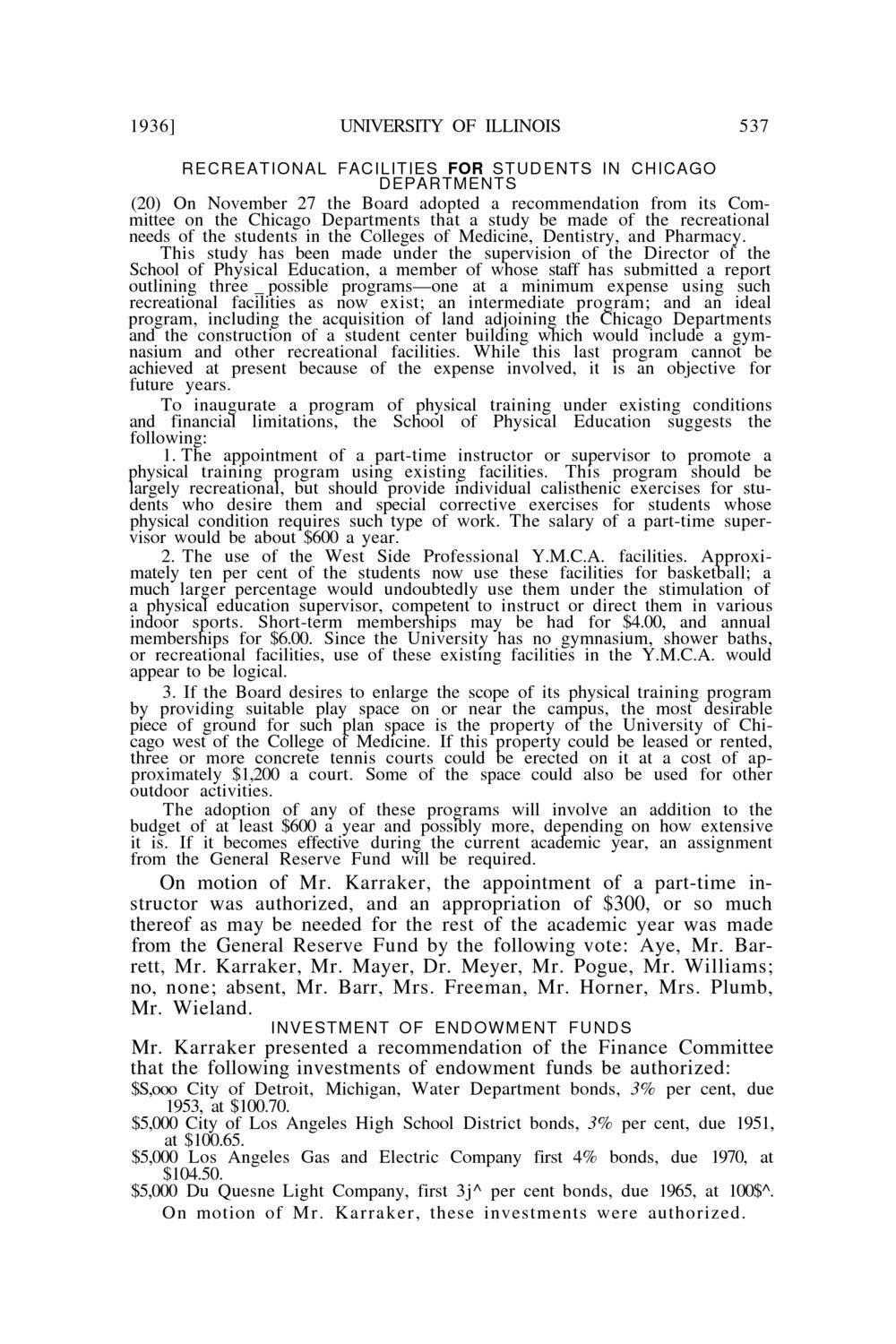| |
| |
Caption: Board of Trustees Minutes - 1936
This is a reduced-resolution page image for fast online browsing.

EXTRACTED TEXT FROM PAGE:
1936] UNIVERSITY OF ILLINOIS RECREATIONAL FACILITIES FOR STUDENTS IN CHICAGO DEPARTMENTS 537 (20) On November 27 the Board adopted a recommendation from its Committee on the Chicago Departments that a study be made of the recreational needs of the students in the Colleges of Medicine, Dentistry, and Pharmacy. This study has been made under the supervision of the Director of the School of Physical Education, a member of whose staff has submitted a report outlining three _ possible programs—one at a minimum expense using such recreational facilities as now exist; an intermediate program; and an ideal program, including the acquisition of land adjoining the Chicago Departments and the construction of a student center building which would include a gymnasium and other recreational facilities. While this last program cannot be achieved at present because of the expense involved, it is an objective for future years. To inaugurate a program of physical training under existing conditions and financial limitations, the School of Physical Education suggests the following: 1. The appointment of a part-time instructor or supervisor to promote a physical training program using existing facilities. This program should be largely recreational, but should provide individual calisthenic exercises for students who desire them and special corrective exercises for students whose physical condition requires such type of work. The salary of a part-time supervisor would be about $600 a year. 2. The use of the West Side Professional Y.M.C.A. facilities. Approximately ten per cent of the students now use these facilities for basketball; a much larger percentage would undoubtedly use them under the stimulation of a physical education supervisor, competent to instruct or direct them in various indoor sports. Short-term memberships may be had for $4.00, and annual memberships for $6.00. Since the University has no gymnasium, shower baths, or recreational facilities, use of these existing facilities in the Y.M.C.A. would appear to be logical. 3. If the Board desires to enlarge the scope of its physical training program by providing suitable play space on or near the campus, the most desirable piece of ground for such plan space is the property of the University of Chicago west of the College of Medicine. If this property could be leased or rented, three or more concrete tennis courts could be erected on it at a cost of approximately $1,200 a court. Some of the space could also be used for other outdoor activities. The adoption of any of these programs will involve an addition to the budget of at least $600 a year and possibly more, depending on how extensive it is. If it becomes effective during the current academic year, an assignment from the General Reserve Fund will be required. On motion of Mr. Karraker, the appointment of a part-time instructor was authorized, and an appropriation of $300, or so much thereof as may be needed for the rest of the academic year was made from the General Reserve Fund by the following vote: Aye, Mr. Barrett, Mr. Karraker, Mr. Mayer, Dr. Meyer, Mr. Pogue, Mr. Williams; no, none; absent, Mr. Barr, Mrs. Freeman, Mr. Horner, Mrs. Plumb, Mr. Wieland. INVESTMENT OF ENDOWMENT F U N D S Mr. Karraker presented a recommendation of the Finance Committee that the following investments of endowment funds be authorized: $S,ooo City of Detroit, Michigan, Water Department bonds, 3% per cent, due 1953, at $100.70. $5,000 City of Los Angeles High School District bonds, 3% per cent, due 1951, at $100.65. $5,000 Los Angeles Gas and Electric Company first 4% bonds, due 1970, at $104.50. $5,000 Du Quesne Light Company, first 3j^ per cent bonds, due 1965, at 100$^. On motion of Mr. Karraker, these investments were authorized.
| |